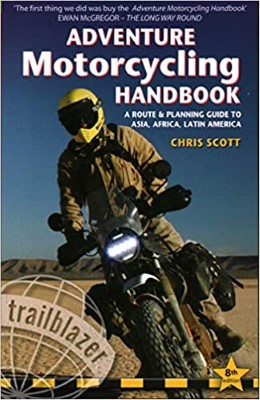 9Likes 9Likes
 |
|

6 Jan 2016
|
|
Registered Users
Veteran HUBBer
|
|
Join Date: Sep 2006
Location: Cornwall, in the far southwest of England, UK
Posts: 597
|
|
I stored (laid-up) my bike in Poland for 6 months last year. On my return I naturally wanted to check the tyre pressures before the ‘off’ .. in a westerly direction.
When I was digging-out my little electric pump from under the seat, an old-timer at the storage depot gestured to me, as much as to say "No Problem .. no problem", and with that he reeled out the hose from his firm's compressor .. pointed quizzically at the inflator's nozzle gauge with a enquiring look on his face. He couldn’t speak a word of English btw, let alone count numbers in English.
I needed 35 psi in the rear - and 30 psi in the front - and therefore flashed all my fingers+thumbs three time (30) plus again with one hand (5), thinking that this was clearly indicating to him the number 35 [psi].
Trouble is, my Polish friend interpreted this signal to mean 3.5 Bars!
So off I went, not with 35 psi in the rear but with 3.5 Bars, or over 50 psi.
[And 43 psi in the front.]
I know .. I know, should have checked with my own pressure gauge afterwards just to be sure. But I didn’t. 
Do you know what? I travelled for more than 2,000 km before checking my tyre pressures again .. and then realised the earlier misunderstanding and mistake. And yet, to me, there was no discernible difference between 35 and 50 psi in the rear – and, in the case of the front: 30 psi (2 Bars) and 43 psi (3 Bars).
--------------------------
On the other hand, of course, I have clearly noticed – as have we all, no doubt - that there is definitely a different feel to a bike's handling when your tyre inflations are significantly lower than the recommended pressures.
--------------------------
Moral of the Story: Do what Ted et al said, as it doesn't matter hugely if your apparent tyre pressures go up or down a little bit with altitude. Ultimately, providing you have enough pressure at the bottom of the tyre .. then it won’t look flat! 
|

6 Jan 2016
|
 |
Contributing Member
Veteran HUBBer
|
|
Join Date: Jul 2005
Location: Wirral, England.
Posts: 5,681
|
|
Quote:
Originally Posted by Keith1954

Do you know what? I travelled for more than 2,000 km before checking my tyre pressures again
|
You must have been gliding over the tarmac. 
When new bikes were delivered to dealerships, they're inflated to this pressure. They don't set them before posting them off from the factory.
If I'd forget to adjust them, I'd test ride at 60 PSI.
And usually I'd not notice. Even when giving it some beans.

__________________
Did some trips.
Rode some bikes.
Fix them for a living.
Can't say anymore.
|

6 Jan 2016
|
 |
R.I.P.
Veteran HUBBer
|
|
Join Date: Aug 2003
Location: california
Posts: 3,821
|
|
Quote:
Originally Posted by Keith1954

Do you know what? I travelled for more than 2,000 km before checking my tyre pressures again .. and then realised the earlier misunderstanding and mistake. And yet, to me, there was no discernible difference between 35 and 50 psi in the rear – and, in the case of the front: 30 psi (2 Bars) and 43 psi (3 Bars).
--------------------------
On the other hand, of course, I have clearly noticed – as have we all, no doubt - that there is definitely a different feel to a bike's handling when your tyre inflations are significantly lower than the recommended pressures.
--------------------------
Moral of the Story: Do what Ted et al said, as it doesn't matter hugely if your apparent tyre pressures go up or down a little bit with altitude. Ultimately, providing you have enough pressure at the bottom of the tyre .. then it won’t look flat!  |

I've noticed on some bikes it can be more difficult to "feel" tire pressure differences, especially if just plodding down a straight, dry road on an unfamiliar bike.
But on MOST of my bikes ... I can feel even a 3 to 5 PSI change. My DR650 (Ohlins shock, Race tech forks) is quite sensitive to tire pressure changes. Ride and bump absorption can be harsh if over inflated, and unstable/squirmy if under inflated.
An over inflated front tire can be QUITE dangerous, especially if pushing a bit hard on a twisty WET road on a fully loaded bike. Beware. Also, under hard braking you're more likely to lock up and slide if tires are over inflated and cold.   
Under inflation is more obvious .... IF you're well tuned into your bike via "Seat of the Pants" method.  Trust your gut, if something does not feel right, check it out!
|

6 Jan 2016
|
 |
Contributing Member
Veteran HUBBer
|
|
Join Date: Aug 2011
Location: Home in Essex GB
Posts: 563
|
|
|
Just a thought, would it be fair to say that a great percentage of riding at altitude is done on less than perfect roads. If so would one not have lowered pressure anyway?
__________________
Regards Tim
Learning my craft for the big stuff, it won't be long now and it's not that far anyway
|

6 Jan 2016
|
 |
R.I.P.
Veteran HUBBer
|
|
Join Date: Aug 2003
Location: california
Posts: 3,821
|
|
Quote:
Originally Posted by g6snl

Just a thought, would it be fair to say that a great percentage of riding at altitude is done on less than perfect roads. If so would one not have lowered pressure anyway?
|
Ideally, yes. But plenty of room for variation depending on BIKE weight, luggage weight, pace ... and of course the road itself. How bad is bad? Off road I really prefer to run lower pressures ... but if you go to fast and hit something ... bad news. My last Baja Trip ... riding at night on a remote off road track I hit something ...  No flat, not problem, never even knew it happened until next day.

This pic from earlier trip on same road. At night it was a bit crazy but not all that bad. My problem was I was going too fast.


So running low pressures can come with risks in terms of keeping your wheels safe. Go too low ... you risk bungered up wheels .. or worse, broken wheel.
Go too high and you get a horrible, harsh ride and poor traction and even worse control. I go with LOW pressures and just try to be careful.
  
|

6 Jan 2016
|
|
Registered Users
Veteran HUBBer
|
|
Join Date: Mar 2007
Location: UK
Posts: 4,343
|
|
Quote:
Originally Posted by Tim Cullis

I had the three main gas laws—Boyle's, Charles' and Henry's—drilled into me from my days in BSAC (scuba).
|
With all 3 you can have some fun in the global warming debate. 
__________________
Dave
|

7 Jan 2016
|
|
Registered Users
Veteran HUBBer
|
|
Join Date: Jul 2003
Location: Mimbres, New Mexico, USA
Posts: 511
|
|
As the graph shows, atmospheric pressure at 4,000m is roughly 0.6 of the sea level pressure of 14.7 psi, so if you filled your tires to 30 psi at sea level, the gauge reading at 4,000m would be 30psi + (0.4 x 14.7 psi) = 35.8 psi. Not enough to burst a tire, but plenty to see on a tire gauge.
Think of it this way, if you took your bike to outer space, zero atm, your gauge reading would be one atm (14.7 psi) higher than the sea level reading. That is the most that an altitude change can affect your tires. The change is not a percentage of the initial pressure, but a percentage of the loss of atmospheric pressure. if you started with 100 psi sea level, at 4,000m, you would have 100 + (.4 x 14.7) or 105.8 psi.

|

8 Jan 2016
|
|
Registered Users
Veteran HUBBer
|
|
Join Date: Nov 2013
Posts: 679
|
|
|
That's really interesting - thanks all the for responses.
|

9 Jan 2016
|
|
Banned
HUBB regular
|
|
Join Date: Oct 2015
Posts: 65
|
|
"In 4.000 metres attitude the difference of the pressure will be just 0.600 Bars, or in PSI +/-0.8 so means that a tire at an average of 28 PSI could be 1 PSI more or less, up or down….
Javier...
Dakar Motos
“El mejor remedio para la Boludez, es la Inteligencia…”"
Seems Boludezes rule 
|

9 Jan 2016
|
 |
Registered Users
Veteran HUBBer
|
|
Join Date: Aug 2013
Location: Sunderland
Posts: 242
|
|
|
In my younger days I did the tyre pressure thing when I was racing, how on different tracks at different altitudes how heat in tyre rise to extreme temperatures so scrubbing rubber, cooking your tyres,,,,,,I can tell you that every thing you read is true it is about all those thing mentioned,
but really come on in the would of touring don't worry it's really not that important, you will know what your bike is doing on Tarmac and on soft ground, in any case you will not be going fast enough to make any serious changes,,,,
As ted said ride your bike and don't get involved in a load of bull.
There is guys much more experienced on here than me that will tell you what tyres and inner tubes to use but I think the same answer will be by most its up to you what you are happy with, as regards pressure guide lines are road 30-40,,,,, off road 15-25,,,,, but it's like every thing m8 it's a guide.
Unlike me I just keep my pressures the same road or off road as its not a race
Last edited by Lowrider1263; 12 Jan 2016 at 07:09.
|

11 Jan 2016
|
|
Registered Users
Veteran HUBBer
|
|
Join Date: Nov 2013
Posts: 679
|
|
|
Altitude and tire pressure?
Quote:
Originally Posted by Lowrider1263

In my younger days I did the tyre pressure thing when I was racing, how on different tracks at different altitudes how heat in tyre rise to extreme temperatures so scrubbing rubber, cooking your tyres,,,,,,I can tell you that every thing you read is true it is about all those thing mentioned,
but really come on in the would of touring don't worry it's really not that important, you will know what your bike is doing on Tarmac and on soft ground, in any case you will not be going fast enough to make any serious changes,,,,
As ted said ride your bike and don't get involved in a load of bull.
There is guys much more experienced on here than me that will tell you what tyres and inner tubes to use but I think the same answer will be by most its up to you what you are happy with, as regards pressure guide lines are road 30-40,,,,, off road 15-25,,,,, but it's like every thing m8 it's a guide.
Unlike me I just keep my pressures the same road or off road as its not a race
|
Totally, I'm riding a 250 around Latin America, I couldn't care less about minor performance quirks. It was just that after coming down in altitude my rear was flat the next day, so it got me thinking how much air pressure can affect tires. That was it really.
|

12 Jan 2016
|
 |
Registered Users
Veteran HUBBer
|
|
Join Date: Aug 2013
Location: Sunderland
Posts: 242
|
|
Quote:
Originally Posted by ridetheworld

Totally, I'm riding a 250 around Latin America, I couldn't care less about minor performance quirks. It was just that after coming down in altitude my rear was flat the next day, so it got me thinking how much air pressure can affect tires. That was it really.
|
I've never suffered from pressure loss,,,,well I don't think I have,,, I don't know if northern Italy qualifies as the same sort of altitude you have done,
It would be interesting to know what your tyre pressure was before you went up and what your pressure was when you come down, did you have a cap on the valve
|

12 Jan 2016
|
 |
R.I.P.
Veteran HUBBer
|
|
Join Date: Aug 2003
Location: california
Posts: 3,821
|
|
Quote:
Originally Posted by ridetheworld

Totally, I'm riding a 250 around Latin America, I couldn't care less about minor performance quirks. It was just that after coming down in altitude my rear was flat the next day, so it got me thinking how much air pressure can affect tires. That was it really.
|
Could be several things, as discussed in this thread. Could even be someone let air out of your tire?  (kids?)
Twice, while traveling in France, had folk flatten my tires because they did not like where I'd parked the bike. (parked it for security). So they let air out. This happened to some of our guys in Mexico as well (vandalism in that case).
But could also be temperature and moisture in air. All affect PSI readings more so than Altitude. Riding hard with loaded bike for hours will raise pressures. Once things cool, PSI drops right off. Learn to do COLD and HOT checks to determine the differential between the two. In my experience moist air in tube has a BAD affect on pressure readings. 
|

12 Jan 2016
|
|
Registered Users
Veteran HUBBer
|
|
Join Date: Nov 2013
Posts: 679
|
|
|
Altitude and tire pressure?
Molly thought the same, could have been kids or something. I think the tire was probably low already at altitude but it was dead flat, so maybe it was something else. Valve was definitely capped.
|
|
Currently Active Users Viewing This Thread: 1 (0 Registered Users and/or Members and 1 guests)
|
|
|
 Posting Rules
Posting Rules
|
You may not post new threads
You may not post replies
You may not post attachments
You may not edit your posts
HTML code is Off
|
|
|
|

Check the RAW segments; Grant, your HU host is on every month!
Episodes below to listen to while you, err, pretend to do something or other...

2020 Edition of Chris Scott's Adventure Motorcycling Handbook.
"Ultimate global guide for red-blooded bikers planning overseas exploration. Covers choice & preparation of best bike, shipping overseas, baggage design, riding techniques, travel health, visas, documentation, safety and useful addresses." Recommended. (Grant)

Led by special operations veterans, Stanford Medicine affiliated physicians, paramedics and other travel experts, Ripcord is perfect for adventure seekers, climbers, skiers, sports enthusiasts, hunters, international travelers, humanitarian efforts, expeditions and more.
Ripcord Rescue Travel Insurance™ combines into a single integrated program the best evacuation and rescue with the premier travel insurance coverages designed for adventurers and travel is covered on motorcycles of all sizes.
(ONLY US RESIDENTS and currently has a limit of 60 days.)
Ripcord Evacuation Insurance is available for ALL nationalities.
What others say about HU...
"This site is the BIBLE for international bike travelers." Greg, Australia
"Thank you! The web site, The travels, The insight, The inspiration, Everything, just thanks." Colin, UK
"My friend and I are planning a trip from Singapore to England... We found (the HU) site invaluable as an aid to planning and have based a lot of our purchases (bikes, riding gear, etc.) on what we have learned from this site." Phil, Australia
"I for one always had an adventurous spirit, but you and Susan lit the fire for my trip and I'll be forever grateful for what you two do to inspire others to just do it." Brent, USA
"Your website is a mecca of valuable information and the (video) series is informative, entertaining, and inspiring!" Jennifer, Canada
"Your worldwide organisation and events are the Go To places to for all serious touring and aspiring touring bikers." Trevor, South Africa
"This is the answer to all my questions." Haydn, Australia
"Keep going the excellent work you are doing for Horizons Unlimited - I love it!" Thomas, Germany
Lots more comments here!

Every book a diary
Every chapter a day
Every day a journey
Refreshingly honest and compelling tales: the hights and lows of a life on the road. Solo, unsupported, budget journeys of discovery.
Authentic, engaging and evocative travel memoirs, overland, around the world and through life.
All 8 books available from the author or as eBooks and audio books
Back Road Map Books and Backroad GPS Maps for all of Canada - a must have!
New to Horizons Unlimited?
New to motorcycle travelling? New to the HU site? Confused? Too many options? It's really very simple - just 4 easy steps!
Horizons Unlimited was founded in 1997 by Grant and Susan Johnson following their journey around the world on a BMW R80G/S.
 Read more about Grant & Susan's story
Read more about Grant & Susan's story
Membership - help keep us going!
Horizons Unlimited is not a big multi-national company, just two people who love motorcycle travel and have grown what started as a hobby in 1997 into a full time job (usually 8-10 hours per day and 7 days a week) and a labour of love. To keep it going and a roof over our heads, we run events all over the world with the help of volunteers; we sell inspirational and informative DVDs; we have a few selected advertisers; and we make a small amount from memberships.
You don't have to be a Member to come to an HU meeting, access the website, or ask questions on the HUBB. What you get for your membership contribution is our sincere gratitude, good karma and knowing that you're helping to keep the motorcycle travel dream alive. Contributing Members and Gold Members do get additional features on the HUBB. Here's a list of all the Member benefits on the HUBB.
|
|
|